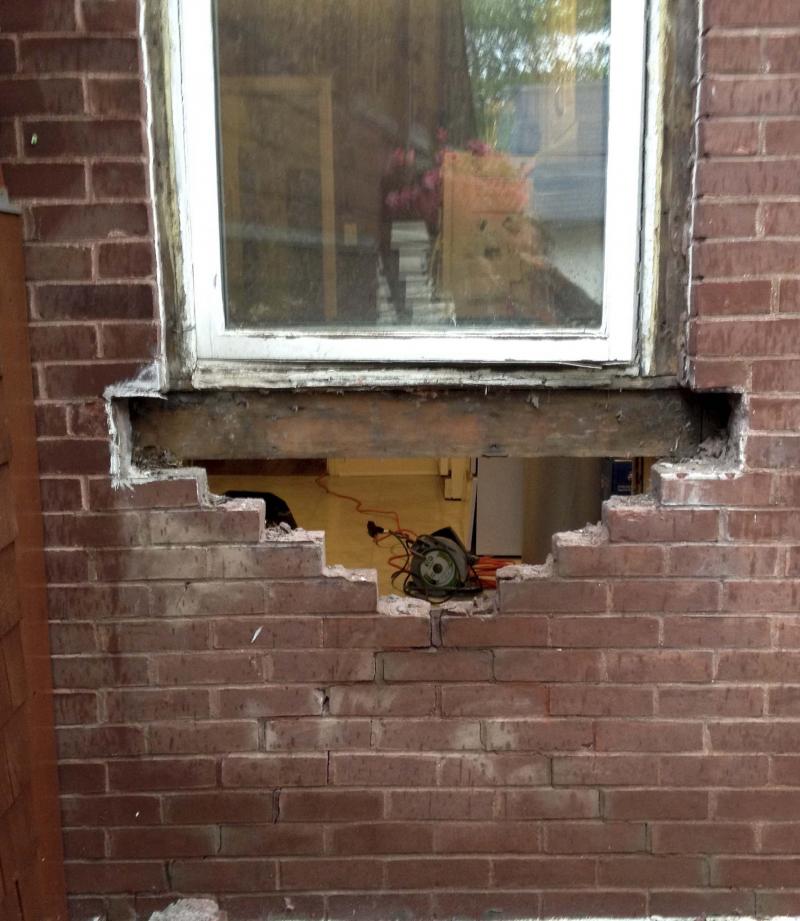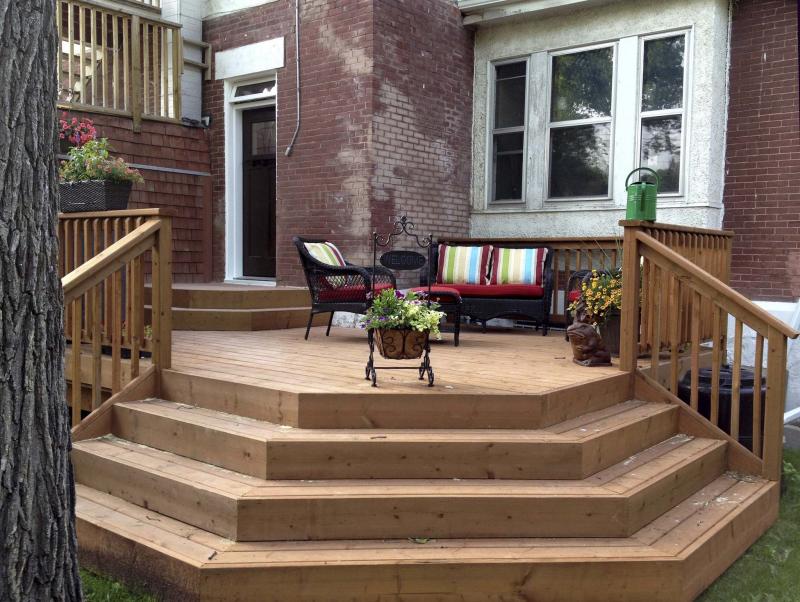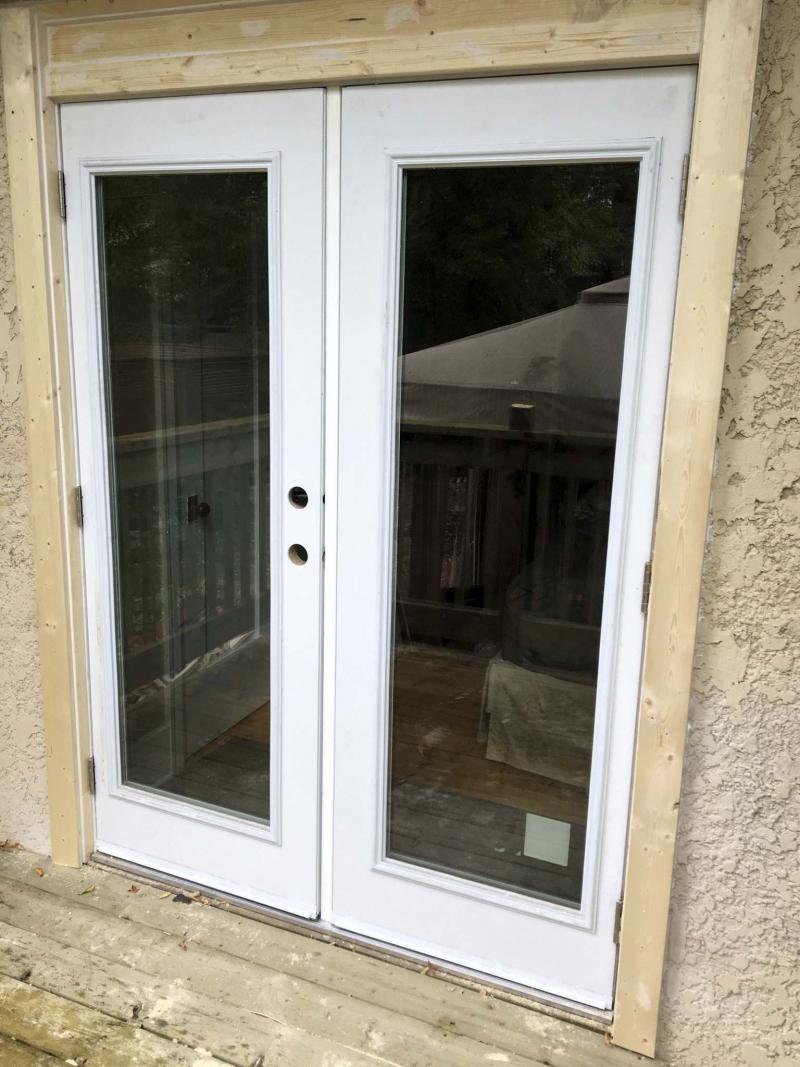
The initial stages of brick removal during the wall breach to create the new back door.

Photos by Marc Labossiere / Winnipeg Free Press
A former kitchen window removed to create space for a new back door leading straight onto the deck.

Rena – double door.jpg,
showcases finished install of double patio door at Rena Semenko’s home with appropriate trim (exterior)
Photos by Marc LaBossiere
There’s no doubt about it — busting through an existing exterior wall to introduce a new entryway can be a nerve-racking renovation. It is next to impossible to predict what’s within the wall cavity — you just don’t know until you open it up. Often clients will ask whether it’s viable to replace an existing window with a doorway. There are many aspects to consider before such a project can proceed.
Once I completed a backyard deck build for my client Renate Singh who lives off Wellington Crescent, it was time to plan out and tackle the final phase of the plan. The rear deck borders two exterior brick walls and quite nicely utilizes the available yard space. It was, however, not yet possible to access the deck unless you were already outside. A window on the far wall in the kitchen was the ideal location for a doorway. Since the exterior walls were brick, it was necessary to precisely assess what was within the wall, and how the wall was constructed — before abandoning the window and breaching the wall entirely.
The interior wall below the window was first addressed by cutting out the plaster to the rough opening dimensions for the door. It’s an old house — metal lath and several layers of wood strips were also removed which eventually revealed insulation within the stud cavities. Luckily, there was no wiring to be re-routed in this instance. Because the top edge of this window well surpassed the height of a door, and any attempt to fill the void above the door’s exterior side with matching brick would always remain obvious, it was decided that the best way to accommodate the space above the door was with a vented window. Therefore, several weeks prior to the installation date, an exterior decorative door and custom vented window were ordered.
Once both the new door and window were on site, confirmation measurements were taken and the full breach began. The brick mould around the existing window was purged and the brick below the original window was carefully cut-out to the rough opening measurements of the door, using a masonry saw. With the brick-cuts completed, the window-frame was lifted out and the existing stud framing which remained below was then removed. The new door was positioned, levelled and secured into place. The vented window was then framed in above the door. The exterior finishing included new brick mould which caters to the theme of the house, a few brick mortar touch-ups and primer and paint on the custom wood trim. Access to the deck from the kitchen was granted!
It is important to understand how the framing of an exterior wall supports the load that bears on a wall opening. Within the framework of the studs, are ledgers above every door and window. A ledger is a horizontal beam, made with two laminated two-by-eights or two-by-10s, which sit on short studs at each end, secured to adjacent king studs which span the entire wall height, from floor to ceiling. The ledger is longer than the rough opening is wide, to lend support across the entire distance above the door or window. In the case of a window, short studs complete the framework below the window. For Singh’s project, the original window width matched the width of the new door. Therefore, it wasn’t necessary to disturb the existing ledger. Had the new door been wider than the original window, it would have been necessary to perform a much more invasive interior breach, to properly re-frame the wall in order to establish a longer ledger which could accommodate a wider opening.
I built a small backyard porch deck for Rena Semenko a few weeks ago, which mimics the front porch I previously built for her, and was showcased in a May 2017 Reno Boss column titled "Making A Great First Impression." Much like Singh’s scenario, a window in Semenko’s master bedroom was removed, and the remaining wall was breached to provide a rough opening to satisfy a double patio door that swings outward. With the door on-site, measurements were confirmed and the breach began. An older home once again, the interior plaster wall, metal lath and wooden strips were cut and carefully removed. Once the stud cavity was revealed, I then cut away the exterior stucco in the same fashion. The old window unit was dislodged and the remaining framework below was removed. The double door was set into place with the help of Singh’s son Ethan and fastened to the existing framing. With luck again on our side, the width of the new door matched the width of the original window, allowing the existing ledger to remain intact, thus minimizing wall-breach intrusion. The original window did, however, sit slightly higher than the new door. This simply required additional framing above the door and some creative trim work to fill the void. With the highly anticipated backyard access from her bedroom onto a new back porch deck, Singh recently commented "I love it!" She intends to paint the exterior door and trim herself — the colour combination has yet to be determined.
At my place, introducing sliding patio doors from my kitchen to the back deck and barbecue was more complicated. Not only did I contend with exterior brick, it would be a complete breach, where no opening ever existed. A much larger removal area of the interior walls was required to properly frame in a ledger, to accommodate the five-foot slider. Removal of the drywall also revealed electrical wiring which needed to be re-routed. But worst of all, to my shock and dismay, all second-floor ventilation ducts to that side of the house ran up through this exterior wall, precisely where I wanted to position the slider. This delayed the door install considerably. The existing ducts were removed and repositioned to either side of the sliding door’s rough opening, which meant jackhammering through the concrete foundation from below and repositioning the tie-ins to the main furnace duct. But once the affected services were properly re-routed, the door could then easily be secured to the framing and both interior and exterior finishing was then achieved. If only I had X-ray eyes.
Adding doorways to your home will increase convenience. Although it can be a daunting task, it is always possible to breach existing walls, and introduce a new door, provided it is done properly. Expect surprises within the walls. Luck was on our side in the two clients’ examples — this allowed for quick and easy installations. Although my personal experience was more challenging, it was well worth the aggravation.
BossEnterprise@outlook.com



